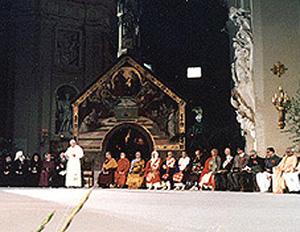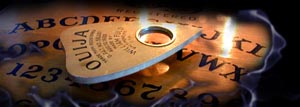 |
Ambiences and Tendencies
Nothing New in the New Age
Joseph Sheppard
The modern “New Age movement” is not a new phenomenon. At its heart it is the ultimate expression of individual egoism and pride, an expression witnessed in numerous historical manifestations. Two of these manifestations are secret societies and so-called “theosophical” societies. These two groups are kindred spirits. They both seek to find a higher truth through rediscovery of pagan superstitions.

Would the Conciliar Church at Assisi wish to be part
of the New Age? |
Somehow members of these sects feel that their own exploration of all religions (except that of the Church established by Our Lord) will reveal the truth about their place in the cosmos. A prerequisite in this exploration of beliefs is that no particular religion is the one true faith. All expressions of worship are created equal, and are a result of a common spiritual “energy.”
One wonders, after the modern examples at Assisi, whether the post-conciliar Church wishes to be New Age. Traditionally, the Catholic Church does not fall into the New Age panorama of acceptable religions because it is “organized” (hierarchical) and restrictive (defines what is good and evil).
The leaders of the Protestant Revolt were imbued with the same spirit that attracts the disciples of the New Age. In varying degrees, Luther, Zwingli, Calvin, Hus, and others rejected the authority of the Church and her hierarchy and favored interpretation of Holy Scripture. The same desire to “shake off the yoke” of the Church in order to rationalize a new age of indulgence (without indulgences) existed then as it does today. However, even several of the radical deformers of the 16th Century provided for some hierarchy and regulation.
Today the New Age mentality appeals to the free-thinker, the young and gullible, and those seeking a spiritual home that glorifies the ego. It also appeals to those looking for an easy path to wealth. Our age is particularly open to the superstitions of the New Age, as people have lost respect for, and trust in, an ineffective and inconsistent Church Hierarchy. Once again, there is a growing dislike for anything structured.

The New Age mentality appeals to occultist exercises involving sorcery and ouiji boards

|
The New Age promises contentment through self-awareness. The proof of this is seen in a focus on predicting the future (fortune-telling, clairvoyance, etc.), contacting the dead through seances, discovering “past lives,” and using sorcery to produce “miraculous” effects. Finally, one can not do a search on the Internet for “New Age” without producing numerous references to witchcraft. In all these evil activities, the participant is made to believe that they are channeling some power that they have invoked. The person is made to believe, to their own demise, that they are god-like, while the true God is mocked.
The term “New Age” is for most synonymous with the “Age of Aquarius.’ The pseudoscience of astrology has provided an excuse to usher in what actually is a cultural revolution. New-agers are often associated with feminism, eco-fanaticism, and anti-capitalist currents. There is also, as previously alluded to, a dislike of organized religion.
Another modern manifestation of the New Age is a plethora of self-made gurus marketing New Age products from books to high-tech gear. Many clever men and women are able to make a good wage at totally invented “realities.” Borrowing from the techniques of Madison Avenue and using the tools of late-night talk radio and the computer website, these high-tech gypsies apply a veneer of respectability to their scams. The carrot dangled before the prospective New Age customer is the promise of tapping into unlimited power for personal use. It is sobering to realize what a huge marketplace exists for these contemporary charlatans.
Throughout the Church’s History, false sects have gained adherents when her Shepherds were not vigilant. Today, not only is there a lack of vigilance, but there is evidence that some of her Shepherds are encouraging false sects. Was it a New Age prophet that uttered the following words:
“Man must be affirmed for himself, and not for any other reason or motive: only for himself alone! Even more, man must be loved because he is man.” (1)
It is the New Age mentality, among others, that seeks to affirm man for himself. The Church, historically, teaches:
“We ought to love ourselves because God wills it; furthermore because we are made after God’s image, redeemed by the blood of Christ, and called to eternal felicity in Heaven.”
“Learn first to love God,” says St. Augustine, “then to love thyself; then thy neighbor as thyself.”(2)
(1) John Paul II, Speech to the Cultural World, in Seoul, S. Korea, May 5, 1984, L’ Obsservatore Romano, May 6, 1985, Supplement, p. XII. (As quoted in Animus Delendi II by Atila Sinke Guimaraes, p. 63).
(2) Spirago-Clarke, The Catechism Explained, (Rockford, IL: TAN, 1993), p.305.
In February of 2003 the Vatican released a 90-page booklet that addressed the New Age movement. The booklet is entitled Jesus Christ the Bearer of the Water of Life: A Christian Reflection on the ‘New Age.’ The document quotes Pope John Paul II, seeming to contradict his earlier expressions of support for the “cult of man”:
“John Paul II warns with regard to the “return of ancient gnostic ideas under the guise of the so-called New Age: We cannot delude ourselves that this will lead toward a renewal of religion. It is only a new way of practicing gnosticism – that attitude of the spirit that, in the name of a profound knowledge of God, results in distorting His Word and replacing it with purely human words. Gnosticism never completely abandoned the realm of Christianity. Instead, it has always existed side by side with Christianity, sometimes taking the shape of a philosophical movement, but more often assuming the characteristics of a religion or a para-religion in distinct, if not declared, conflict with all that is essentially Christian”.(3)
(3) John Paul II, Crossing the Threshold of Hope, (Knopf) 1994, 90. (As quoted by the Pontifical Council For Culture - Pontifical Council For Interreligious Dialogue, Jesus Christ, the Bearer of the Water of Life: A Christian Reflection on the New Age, February 3, 2003).
God says: “The soul that shall go aside after magicians and soothsayers I will destroy out of the midst of its people” (Lev. xx.6). Clearly, the superstitions and pagan beliefs that are integral to the so-called “New Age movement” are a sin against the First Commandment.

Posted October 24, 2003
|
Ambiences | Cultural | Home | Books | CDs | Search | Contact Us | Donate

© 2002- Tradition in Action, Inc. All Rights Reserved
|
 |

|